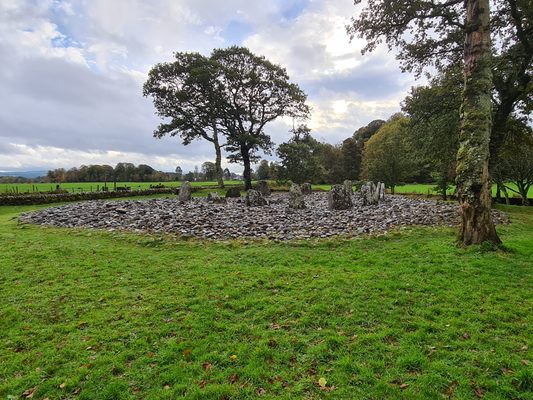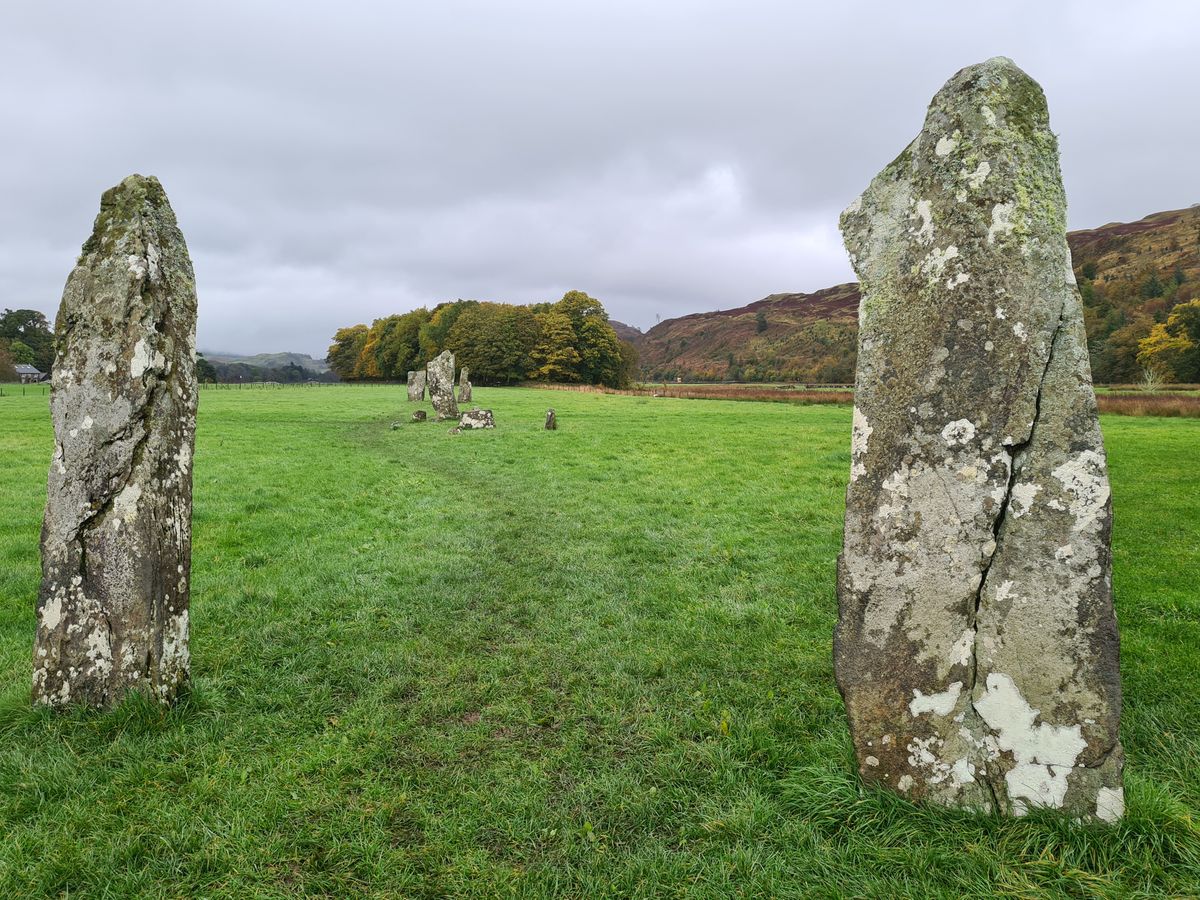About
Over 5,000 years of human history have been preserved in the monuments surrounding Kilmartin village. The landscape around Kilmartin Glen is generously dotted with cairns, standing stones, carved rocks, stone circles, forts, castles, and a henge. This plethora of monuments means that Kilmartin Glen is considered to have one of the most important concentrations of Neolithic and Bronze Age remains in Scotland. There are more than 800 ancient monuments within a six-mile radius of the current Kilmartin village, with 150 of them being prehistoric.
Monuments that can be accessed from Kilmartin village include an unusual layout of standing stones, a couple of stone circles with cists, and a ‘linear cemetery’ comprising five remaining burial cairns. Several of these monuments, as well as many natural rocks, are decorated with cup and ring marks, as well as some more unusual carvings.
At one end of the site accessible from Kilmartin is Ri Cruin Cairn. This is the most southerly cairn in what is called the linear cemetery, a line of burial cairns running on a north-to-south alignment. Ri Cruin is believed locally to be the possible burial location of a king. The cairn was built between 2200 B.C. and 1950 B.C. It had a central cist burial and two further internments that were added later, one of which was positioned just beyond the cairn's kerb. More recently, this cairn was used as a lime kiln. Three excavations have taken place at the site. What you see today is mostly a reconstruction—all traces of the lime kiln were removed following the reconstruction of the site.
Walking north along the road, the next site you will come to is the Temple Wood stone circles. The southern circle contains a ring of 13 standing stones about 12 meters in diameter. It is thought that in the past the circle may have had as many as 22 standing stones. In the center is a burial cist surrounded by a second circle of stones about three meters in diameter. It is thought that the southern circle's first incarnation may have been constructed around 3000 B.C. Look for the spiral carving on one of the remaining stones. The northern circle is smaller and consists of rounded river stones. In the middle is a single stone, another stone is found on the edge of the circle. This smaller circle may have originated as a timber circle with the timbers replaced with stones at a later date.
Nether Largie standing stones are located southeast of the Temple Wood stone circles and are accessed across the little road. They are made up of four standing stones, arranged in pairs approximately 70 meters apart, with a single standing stone in the middle forming an X shape. Around the central stone are seven smaller stones and one fallen stone. This central stone has some of the more visible cup and ring carvings. Another single standing stone is positioned one hundred meters to the northwest leading back towards the stone circles in Temple Wood.
Next is the Nether Largie Cairns. Today there are three cairns, but originally there would have been four—one was lost around the 1880s. See if you can work out where it might have been, it's actually not that difficult to spot if you can read the landscape!
Nether Largie South is the oldest monument of the linear cemetery. It is a Neolithic chambered cairn, probably dating from around 4000 B.C. The cairn was probably originally around 40 meters in diameter and four meters high, although stone robbing to build walls, drains and roads have reduced its size over the years. The internal chamber is subdivided into four by floor slabs. Although now exposed, the chamber would have originally been encased within the cairn. This chamber is currently open and visitors can enter to see the interior of the cairn.
Nether Largie Mid Cairn was first excavated in 1929, shortly after much of the stone had been reused in roadbuilding. It is around 30 meters across, and was formerly three meters in height. Kerbstones, which formed the boundary edge of the cairn, can still be seen. Inside two cists were found, with cup marks, and a carving of an axehead found on the southern cist. Though it was likely a burial site, no evidence of human remains was found during the excavations—any bodies buried here had likely been dissolved by the acidic soil.
Nether Largie North Cairn like the others in the linear cemetery, is a large round cairn. It dates to around 5,000–3,500 years ago. An examination of its central cist found approximately 40 cup and ring marks and pecked carvings of two axeheads on its capstone. This raises the question could this capstone have been re-used from an even older standing stone site? There were two stone pillars nearby that are thought to have been taken from one of the Temple Wood stone circles.
The most northerly cairn, Glebe Cairn is situated to the west of the current Kilmartin Village. The cairn was excavated in 1864, and two concentric stone circles were found beneath the pile of stones. Two cist burials were found at this cairn, a woman in the center of the two concentric stone circles and a man further towards the edge of the cairn. The cairn was then built up over the top.
Related Tags
Know Before You Go
There are several places to park, with disabled parking at Ri Cruin and Temple Wood and car parks near Nether Largie Stone Circle and Kilmartin village. If you do not want to walk from one end to the other and back, you can drive along.
The site covers over 4 kilometres and, despite the designated disabled parking spaces, the whole site is not wheelchair accessible, with only stile access to some of the sites, including Ri Cruin!
Published
November 23, 2021













































